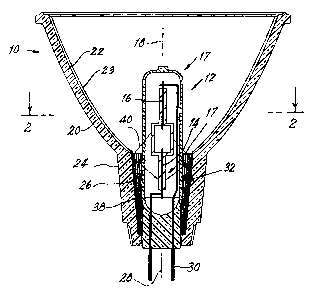Some of the information on this Web page has been provided by external sources. The Government of Canada is not responsible for the accuracy, reliability or currency of the information supplied by external sources. Users wishing to rely upon this information should consult directly with the source of the information. Content provided by external sources is not subject to official languages, privacy and accessibility requirements.
Any discrepancies in the text and image of the Claims and Abstract are due to differing posting times. Text of the Claims and Abstract are posted:
| (12) Patent Application: | (11) CA 2489651 |
|---|---|
| (54) English Title: | REFLECTOR LAMP WITH REDUCED SEAL TEMPERATURE |
| (54) French Title: | LAMPE A REFLECTEUR ASSURANT LA REDUCTION DE TEMPERATURE DU JOINT |
| Status: | Deemed Abandoned and Beyond the Period of Reinstatement - Pending Response to Notice of Disregarded Communication |
| (51) International Patent Classification (IPC): |
|
|---|---|
| (72) Inventors : |
|
| (73) Owners : |
|
| (71) Applicants : |
|
| (74) Agent: | SMART & BIGGAR LP |
| (74) Associate agent: | |
| (45) Issued: | |
| (22) Filed Date: | 2004-12-07 |
| (41) Open to Public Inspection: | 2005-09-15 |
| Availability of licence: | N/A |
| Dedicated to the Public: | N/A |
| (25) Language of filing: | English |
| Patent Cooperation Treaty (PCT): | No |
|---|
| (30) Application Priority Data: | ||||||
|---|---|---|---|---|---|---|
|
A lamp assembly 10 has a light source 12 having two sealed electrodes 14, 16,
sealed in a
seal area 17 and defining a lamp axis 18. A concave shell 20 has an internal
surface 22 with
a reflective surface 23 formed thereon. The concave shell 20 has a neck 24
defining a neck
cavity 26 and a reflector axis 28. The neck 24 is provided with an electrical
connection 30
and a mechanical support for the light source12. The shell 20 surrounds the
source 12 to
reflect light from the source 12 to a field to be illuminated during lamp
operation. The
source 12 and the reflector surface 23 are oriented with the lamp axis18
substantially co-axial
with the reflector axis 28, and at least a portion of at least one of the
electrodes, for example,
14, extends into the neck cavity 26. A zone 32 is formed in the neck cavity 26
for
substantially redirecting specular reflection away from the seal area.
Note: Claims are shown in the official language in which they were submitted.
Note: Descriptions are shown in the official language in which they were submitted.

2024-08-01:As part of the Next Generation Patents (NGP) transition, the Canadian Patents Database (CPD) now contains a more detailed Event History, which replicates the Event Log of our new back-office solution.
Please note that "Inactive:" events refers to events no longer in use in our new back-office solution.
For a clearer understanding of the status of the application/patent presented on this page, the site Disclaimer , as well as the definitions for Patent , Event History , Maintenance Fee and Payment History should be consulted.
| Description | Date |
|---|---|
| Inactive: IPC removed | 2022-02-07 |
| Inactive: IPC assigned | 2022-02-07 |
| Inactive: IPC removed | 2022-02-07 |
| Inactive: IPC expired | 2016-01-01 |
| Inactive: IPC removed | 2015-12-31 |
| Inactive: IPC expired | 2015-01-01 |
| Inactive: IPC expired | 2015-01-01 |
| Inactive: IPC expired | 2015-01-01 |
| Inactive: IPC removed | 2014-12-31 |
| Inactive: IPC removed | 2014-12-31 |
| Inactive: IPC removed | 2014-12-31 |
| Application Not Reinstated by Deadline | 2008-12-08 |
| Time Limit for Reversal Expired | 2008-12-08 |
| Deemed Abandoned - Failure to Respond to Maintenance Fee Notice | 2007-12-07 |
| Inactive: IPC from MCD | 2006-03-12 |
| Inactive: IPC from MCD | 2006-03-12 |
| Inactive: IPC from MCD | 2006-03-12 |
| Inactive: IPC from MCD | 2006-03-12 |
| Inactive: IPC from MCD | 2006-03-12 |
| Inactive: IPC from MCD | 2006-03-12 |
| Inactive: IPC from MCD | 2006-03-12 |
| Inactive: IPC from MCD | 2006-03-12 |
| Application Published (Open to Public Inspection) | 2005-09-15 |
| Inactive: Cover page published | 2005-09-14 |
| Inactive: IPC assigned | 2005-02-08 |
| Inactive: First IPC assigned | 2005-02-08 |
| Inactive: Filing certificate - No RFE (English) | 2005-01-25 |
| Filing Requirements Determined Compliant | 2005-01-25 |
| Application Received - Regular National | 2005-01-24 |
| Letter Sent | 2004-12-07 |
| Abandonment Date | Reason | Reinstatement Date |
|---|---|---|
| 2007-12-07 |
The last payment was received on 2006-11-15
Note : If the full payment has not been received on or before the date indicated, a further fee may be required which may be one of the following
Please refer to the CIPO Patent Fees web page to see all current fee amounts.
| Fee Type | Anniversary Year | Due Date | Paid Date |
|---|---|---|---|
| Registration of a document | 2004-12-07 | ||
| Application fee - standard | 2004-12-07 | ||
| MF (application, 2nd anniv.) - standard | 02 | 2006-12-07 | 2006-11-15 |
Note: Records showing the ownership history in alphabetical order.
| Current Owners on Record |
|---|
| OSRAM SYLVANIA INC. |
| Past Owners on Record |
|---|
| JEFFREY P. BUSCHMANN |
| MICHAEL R. KLING |